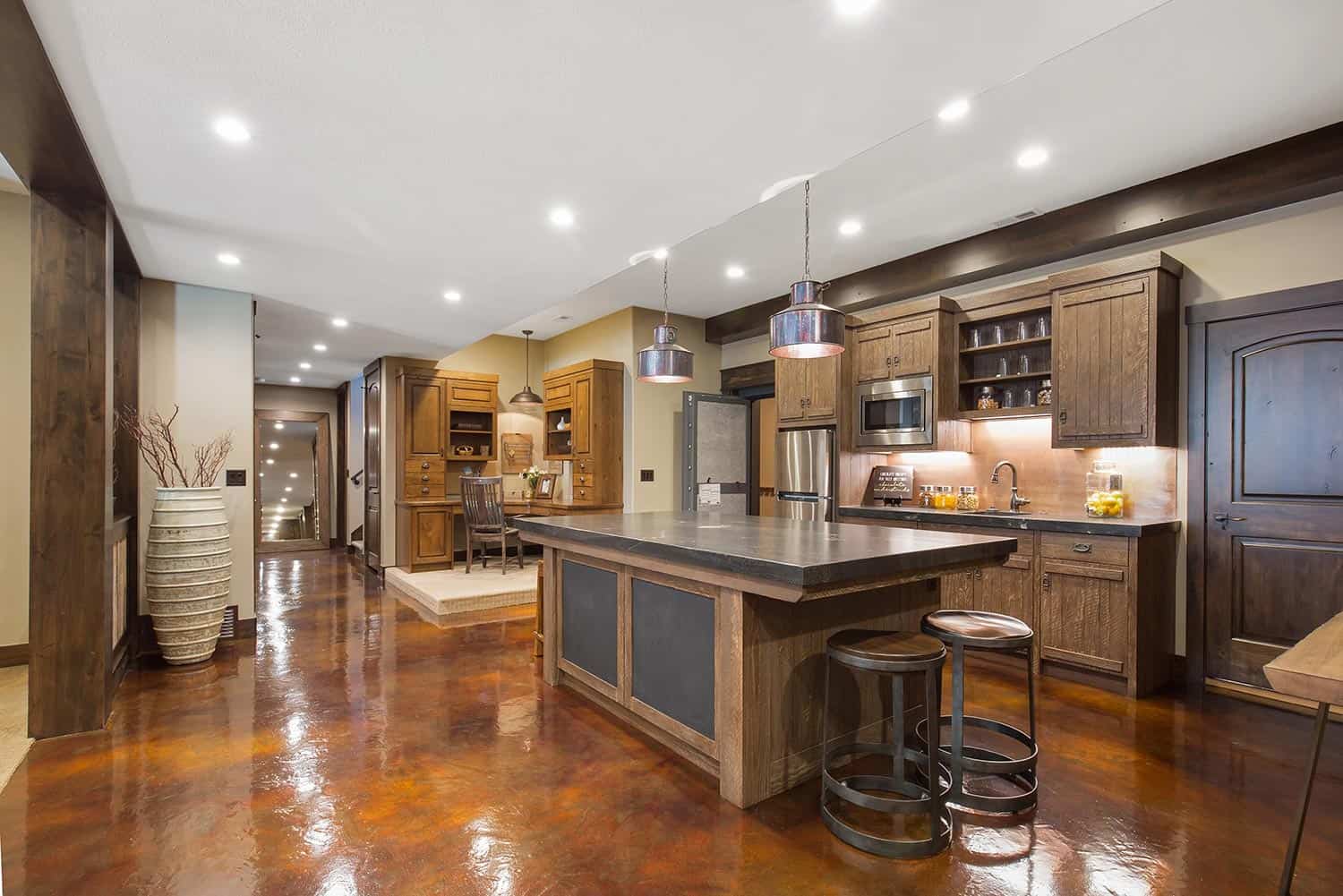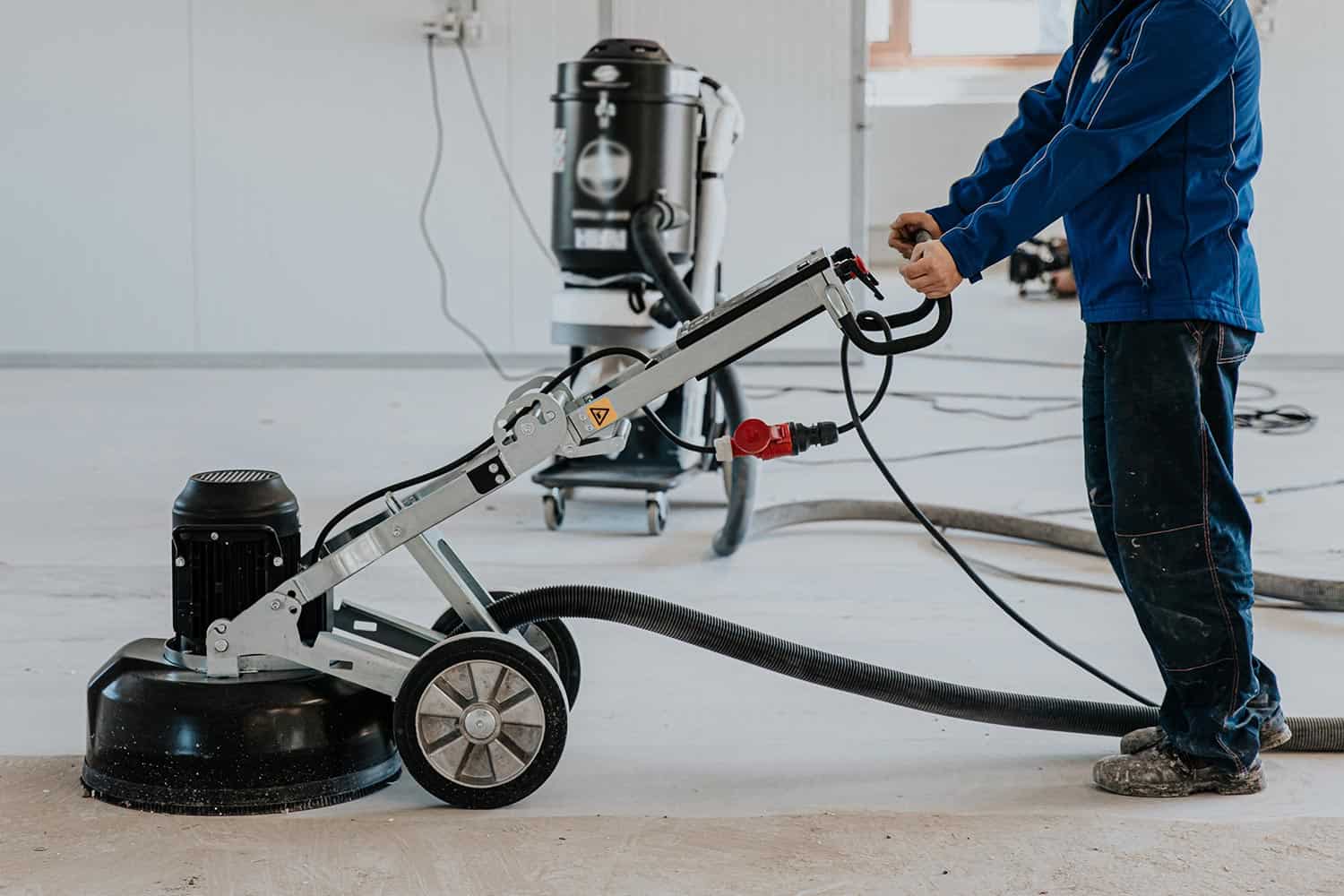Generally, epoxy flooring offers high resistance to wear and tear. It’s a relatively long-lasting and fairly inexpensive flooring option for different homes. Now you’re wondering about the distinct pros and cons of epoxy flooring. We researched for your convenience, and here’s what we found.
Epoxy floors generally possess unique pros and cons. Some of these benefits and drawbacks are:
Pros of Epoxy Flooring
- Enhances a home’s aesthetics
- Reasonably inexpensive
- Excellent durability and resistance
- Increased safety
Cons of Epoxy Flooring
- Short lifespan
- Slippery when wet
- Tedious preparation
- Strong smell
Take note that epoxy floors can also come in different types, with each variant possessing distinct features for specific purposes. Keep reading as we talk about these different types of epoxy flooring. We’ll also tackle the pros and cons of this flooring option in greater detail.
![Worker coating floor with self-leveling epoxy resin in industrial workshop, Epoxy Flooring Pros And Cons [A Comprehensive Review of This Versatile Floor Coating]](https://uooz.com/wp-content/uploads/2022/02/Epoxy-Flooring-Pros-And-Cons-A-Comprehensive-Review-of-This-Versatile-Floor-Coating.png)
What Are The Different Types Of Epoxy Flooring?
Epoxy flooring comes in different types, with each model possessing distinct characteristics and features. It also means that each epoxy flooring types will typically have unique advantages and shortcomings.
Here are some of the relatively common types of epoxy flooring and their ideal applications:
- Self-leveling: Ideal for patching damaged or old concrete floors to achieve a smooth and level texture.
- Mortar: Made with 100% solid epoxies mixed with sand, this model is often ideal for high-traffic areas.
- Anti-static: Also called electro-static charge (ESD) resistant flooring, this epoxy flooring can be good for commercial establishments in niches like electronics and healthcare.
- Quartz-filled: Contains anti-slip resistant traits for places like cafeterias, restrooms, and locker rooms.
- Epoxy flake: Generally a smaller variant than other types of epoxy floors, this model can be a good choice for subtle grooves to prevent falls and slips.
At this point, you might also be wondering if it’s possible to coat wood floors with an epoxy finish. If so, read our post on that topic to learn the answer.
Check out this epoxy floor kit on Amazon.
Is Epoxy Flooring Good For Homes?

Epoxy flooring is generally a good choice for many homes. However, property owners should know the unique pros and cons of this flooring material to gain the most value out of it.
Pros of Epoxy Flooring
Enhances Home Aesthetics
Epoxy flooring can help improve the overall aesthetic appeal of certain household themes. In particular, homeowners may agree that epoxy floors with metallic appearances go well with contemporary motifs.
Generally, metallic epoxy flooring can create 3D visual effects that may include (but aren’t limited to):
- Appearances that emulate galaxies, stars, and other heavenly bodies
- 2-toned ripples or swirls that resemble water
- Polished marble effects
With this flooring option, it is safe to say that no two floor designs are exactly alike. Installing this choice promotes individualism to help properties become separated from relatively standard flooring designs.
Reasonably Inexpensive
The costs for installing epoxy floors are generally within the $3 to $7 per square foot range. Homeowners should expect to pay $1 to $2 for the materials and $2 to $5 per square foot for professional services.
In comparison, hardwood floors usually have overheads of about $6 to $12 per square foot. Property owners would typically pay between $3 and $7 per square foot to buy the materials and $3 and $5 per square foot for the expert labor.
Excellent Durability and Resistance
Installing epoxy floors supply many homeowners with a scratch-resistant surface. Manufacturers may also add finishes like urethane to the material, making this flooring more durable than average.
Epoxy is also fairly resistant against cracks, stains, and harsh chemicals. If applied correctly, it may also possess sufficient strength to carry heavy equipment without contracting significant structural damage. The surface is also quite resilient against impacts, giving peace of mind to homeowners and DIY enthusiasts if they accidentally drop their weighty power tools.
Moreover, if a heavy object drops on an epoxy floor and the material receives a scratch, property owners can usually buff out the imperfection with a small amount of floor polish.
Check out this floor polish on Amazon.
Increased Safety
Epoxy surfaces are quite reflective, making them excellent choices for places like garages in reasonably dark neighborhoods. Lot owners wouldn’t need to install bright lights in their garages to help brighten these spaces. In turn, homeowners may also cut energy costs with reduced light usage.
Cons of Epoxy Flooring
Short Lifespan
The serviceable life of a typical epoxy floor only lasts about 2 to 3 years. Spaces with significant traffic and has to deal with heavy equipment might make the lifespan of this flooring option shorter than usual.
Proper care and maintenance may increase the life of the epoxy flooring, but it may only last up to 10 years. In comparison, hardwood floors can last a lifetime with routine upkeep practices. You can also learn more about wooden flooring by reading our post on that material’s thickness.
Slippery When Wet

Typically, epoxy floors possess skid-resistant properties. However, leaving moisture on these surfaces can make them walking hazards as they become slippery.
Aside from water, epoxy flooring can also become slippery when doused with other liquids, such as grease and oil. Therefore, this option isn’t an ideal choice for relatively wet areas like the bathroom.
On the other hand, flooring like bamboo, glass, and ceramic tile might be better options for those spaces. Still, homeowners may mitigate this issue by adding a dehumidifier to the room.
Check out this dehumidifier on Amazon.
Tedious Preparation
Epoxy flooring installation jobs typically demand laborious preparations for their subfloors. For example, here’s a quick preview of the steps to prepare a plywood substrate that can go underneath an epoxy floor:
- Clean existing wood on the rough-in and attach the material to the floor joists.
- Fasten another layer of plywood and stagger this additional sheet to add strength to the setup.
- Install another plywood sheet with the correct underlayment grade. Secure the current assembly with glue.
- Screw each wooden panel’s edge for support.
- Fill the joints with rigid epoxy before covering the joints with epoxy resin and fiberglass cloth.
- Treat each joint with fiberglass mesh.
- Sand the surface lightly and remove the leftover dust with a vacuum cleaner.
- Prime the wooden substrate.
Take note that it can take more than a day to prepare a subfloor. Aside from the steps mentioned above, installers need to exercise rigorous testing practices to ensure the epoxy floor and the underlying substrate will last as long as possible.
Moreover, it may take another day or two to install the epoxy floor on average. The installation period may take longer if individuals that attempt this project attempt to complete it using DIY techniques.
Additionally, installers need to wait at least 12 to 18 hours for the installation to cure. However, it’s ideal to wait at least 36 hours before walking on the epoxy floor to reduce the risks of damaging the setup. But, it’s often best to wait for a week before using the new flooring as this period is, generally, when epoxy cures fully.
Strong Smell
A standard epoxy floor will generally emit vapors. Oftentimes, the scent can be quite strong, which may put off some property owners and guests. Thankfully, the fumes are only at their strongest after the installation and will dissipate over time.
Is Epoxy Flooring Cheaper Than Tile?
Quality ceramic floor tiles cost about $3.99 to $9.99 per square foot on average, making them relatively more expensive than epoxy flooring. Homeowners that choose other tile materials, such as glass and mosaic, should prepare a higher ceiling for spending allowance. It’s because these tile options often require $9.99 to $29.99 per square foot for their average overhead.
How Do You Maintain An Epoxy Floor?

Regular maintenance for epoxy floors usually doesn’t require special equipment or materials. Here are some tips to help increase the serviceable life of these floors:
- Vacuum regularly. Use a soft brush attachment to avoid scratching the epoxy material.
- Use a mild cleaning solution. Epoxy typically doesn’t need harsh chemical cleaners.
- Apply spot cleaning methods. This flooring option is generally easy to clean, thanks to its water-resistant properties.
- Clean gas and oil stains immediately. Chemical spills may cause permanent damage to epoxy if left alone for extended periods.
Are Epoxy Floors Worth It?

Despite having some shortcomings, epoxy flooring can be worth the cost in appropriate scenarios. This flooring choice can be ideal for different applications, such as for floors in commercial warehouses and industrial sites. Homeowners may also choose to install epoxy floors in their garages, thanks to the material’s anti-skid properties.
Final Words
Epoxy floors present many residences and commercial establishments with distinct advantages like increasing overall aesthetics within a reasonably fair price range. However, those who wish to install this flooring option should also expect some shortcomings, such as epoxy’s relatively short lifespan and reduced traction when wet.




Great article! One of the most epoxy floors misconception is it’s slippery when wet. Just adding the suitable anti-skid material is the answer.